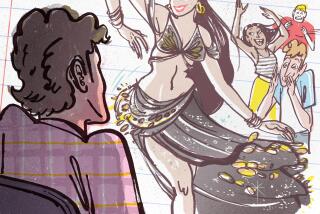JUST STEPS FROM CANADA TO CAIRO : MOVING IN BELLY-DANCING CIRCLES
- Share via
CAIRO — There was a roll of drums, the lights dimmed and the man in the tuxedo took the microphone. “Now,” he shouted, “the moment we have been waiting for. Let us welcome the great Oriental dancer”--his hand swept toward the parting curtain--”Ba-dee-aaaaaa!”
Badia, also known as Brenda Bell of Vancouver, Canada, swept into the hotel ballroom with a flourish, the 10-piece orchestra in musical frenzy. The guests at Mohammed Heba’s wedding reception roared with enthusiasm and toasted Badia with cocktail glasses filled with mineral water.
For nearly an hour, the scantily clad Badia shimmied among the guests, sometimes balancing a candelabrum on her head. The bride and groom sat in throne-like chairs, facing their guests. Their hands touched lightly, the first daring act of intimacy in a religiously conservative society where unmarried couples do not touch, dance or date.
Badia, who wears a diamond in her left nostril and travels with a Yorkshire terrier named Shireen, “broke into the Middle East scene,” as she puts it, in a London club and eventually made her way to Cairo, where she has joined an increasing number of North Americans who are finding fame and sometimes fortune as belly dancers in the Arab world.
No one is sure where belly dancing originated, but there is evidence suggesting that Africa may have been its birthplace. Egypt’s many foreign rulers and conquerors, among them Turks and Albanians, have influenced its present form. Some of Egypt’s earliest written documentation, dating back 5,000 years, speaks of a class of professional dancer-slaves imported from the heart of Africa.
Many were Pygmies, whose artistry made them such prized possessions that one pharaoh prayed to become a “dance dwarf of God” and another ordered his marshals to rush “a dance dwarf from the Land of Spirits” to his court. Their likeness was painted on the walls of tombs so that they could entertain the dead as they had the living.
The popularity of belly dancing, with its mix of Gypsy and Arabic music, has risen and fallen with the morals of the times. In the 18th Century, dancers were banned from the streets of Cairo, but by the early 1900s princes and pashas were selecting dancers from the Mohammed Ali Club here and supporting them in lavish fashion.
Badia, sipping from a rum collins after her performance, said, “A lot of people are shocked when they see me dance because they can’t believe a foreigner can feel the music the way I do.
“The majority of these people are forbidden to get up and move around. They can’t do things like that in their countries. They have these feelings locked up inside that they can’t express. And when I express them for the people, they go crazy.”
Although in many Arab countries--Egypt, Jordan, Syria, Morocco and some of the Persian Gulf states--no grand celebration would be complete without a belly dancer, the erotic nature of the performance seems to clash with the strict morality of Islamic teaching.
Indeed, in early Islamic theater, women were not allowed to perform at all; female roles were filled by men. Later, Christian and Jewish women were allowed to play the parts of Muslim women. To this day, Saudi Arabia allows no theater of any kind--no movies and, most certainly, no belly dancing.
When religious zealots rioted here in 1977, the first targets of their torches were the nightclubs on Pyramid Road, where some visiting Arabs spend their evenings drinking whiskey at $150 a bottle and stuffing money into the bras of belly dancers. “No more filth!” the rioters shouted as smoke billowed from the fires they had set.
But Cairo, the Hollywood of the Middle East for any Arab artist, has made an accommodation of sorts with the moralists. Dancers must wear body stockings when they perform and may not appear on television. And nothing that even hints at being risque gets past the movie censors.
“Dancing was much more respectable, more of an art form, when I performed,” said Taheya Karyoka, one of Egypt’s best-known belly dancers of the 1940s. “We danced in a theater, with an audience, and there was no drinking, no drunk people.
“Now dancers make movements to arouse the desire inside people, and the performances are inside nightclubs, where you find people either completely drunk or half-drunk. It is not right.”
Karyoka has changed her life style since retiring 15 years ago. She prays five times a day, rising before dawn to answer the first call to prayer, and has made several religious pilgrimages to Mecca. Today, she finds some conflict between dancing and Islam.
Egypt’s best-known performers, among them Nagwa Fouad and Fifi Abdu, can command up to $2,500 for performing at a wedding reception, $1,500 at a nightclub. But their overhead is high. They hire their own orchestras and composers and the badlah , the four-piece costume that consists of a bra, girdle, skirt and cloak, can cost as much as $5,000.
The influx of American and Canadian belly dancers into the Middle East coincided with the oil boom of the 1970s. Many of the Westerners have become top-name performers. When Timara Noel Elliot, the daughter of a Montana sheep rancher, completed her contract earlier this year at Damascus’ Orient Club, a popular hangout for Syrian politicians and army officers, the final performance was such an event that state television crews were on hand to film it.
Badia, the Canadian dancer--her stage name means “semi-desert” in Arabic--gets $500 for a wedding performance, and may soon increase her fee to $700. On busy nights, such as New Year’s Eve, she will do as many as six shows, shuttling between nightclubs, hotels and private parties.
“Dancing girls have always had a bad name in the Middle East,” she said. “Someone gets married and finds out his bride’s sister is a dancer, and the reaction is, ‘Uh-oh, better be careful.’
“But I look on Oriental dancing as just another art form, a very difficult one that’s full of emotion. After all, it’s been here since long before Islam.”
More to Read
Sign up for Essential California
The most important California stories and recommendations in your inbox every morning.
You may occasionally receive promotional content from the Los Angeles Times.













